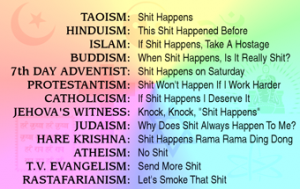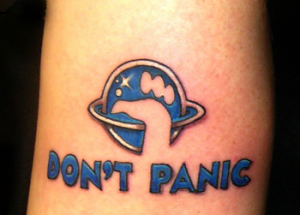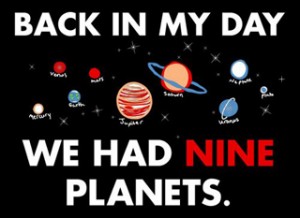“It is not that there are no certainties, it is that it is an absolute certainty that there are no certainties.” Christopher Hitchens (1949-2011) from Hitch-22: A Memoir
In Douglas Adams’ book Life, the Universe and Everything, the computer Deep Thought comes up with the Ultimate Answer to the Ultimate Question of Life, The Universe and Everything. The answer is 42. Unfortunately, the actual question is not known.
In the planet we inhabit, the reverse is often the case. We have questions for which there are no constant, neat and tidy, answers. We fall back on political ideologies, religious tenets, anecdotal experience, artistic genres and/or academic disciplines to give us a belief structure that we sometimes confound with fixed truths. Even when we are confronted with evidence that we aren’t wholly right — because something has changed, more information becomes available or the possible, but improbable, has occurred — it’s hard to let go of our constructed answer.
In the recent past, we’ve struggled to let go of these treasured “truths.”
Pluto is a planet
A house is a good investment
The stock market is a rational determinant of prices and a productive use of capital
Sometimes the Insignificant Isn’t
When I first started at IBM as a chemical engineer, I was responsible for a manufacturing process that was part of our semiconductor packaging line. It was a good place for a new engineer to start. The process to dispense and cure a polymer over the top of a chip and ceramic package was a mature and stable process. But one day, the polymer stopped curing.
I calibrated the curing furnace, but it was well within spec. I reviewed the polymer testing data and even had it retested, but it too was within spec. Out of desperation, I called the polymer vendor. It seems he had changed his manufacturing process. Instead of doing a two-step manufacturing process to produce materials to our specification, he developed a cheaper one-step process.
In the short-term, we specified the two-step process. In the months to come, we discovered a seemingly irrelevant chemical property that was, in fact, critical.
I chose a career in science and engineering because I liked making things work. I was drawn to an endeavor founded on “right answers.” I believed that by knowing the right answers, I had control. But as I would start to learn, controlling my small manufacturing line required more adaptation and flexibility than maintaining a static status quo.
My manufacturing line was finite compared to the stock market. With all the interrelated variables that can move the market — political, economic, financial, technological, competitive, emotional, environmental — I’m always surprised by investors’ reliance on historical relationships and the notion of fixed truths. And that’s one reason why I was anxious to read Nassim Taleb’s Fooled by Randomness: The Hidden Role of Chance in Life and in the Markets.
Sometimes the Significant Isn’t All That
Taleb, in his book and by virtue of his results, dispels a commonly held “truth” that investing in a highly probable event is safe bet. He argues that investors consistently underestimate and misprice the improbable. The revelation put forth by Taleb’s book apparently “rolled down Wall Street like a hand grenade.” While I enjoyed the book, I can’t say I was hit by the same shrapnel as some of my investment peers.
Taleb did a good job discussing the shortcomings of econometrics, the statistical tool many investors use to divine their “answers.” Econometrics is a handy tool to determine the past relationship between variables. For instance, using econometrics you might find that the share price of the two related companies traded in relative lockstep 95% of the time over a two year period. That might lead you to bet that if the share price of one were to rise, the other would soon follow.
 But econometrics makes use of distributional assumptions that aren’t particularly accurate. Even if they were, the prices of the two stocks didn’t always move in lockstep — and may not. Also, econometrics is a hindsight model. What influenced a past relationship may have changed. A myriad of events — a new competitor, a new technology, a flood, a change in currency valuation, etc — could change their present/future relationship.
But econometrics makes use of distributional assumptions that aren’t particularly accurate. Even if they were, the prices of the two stocks didn’t always move in lockstep — and may not. Also, econometrics is a hindsight model. What influenced a past relationship may have changed. A myriad of events — a new competitor, a new technology, a flood, a change in currency valuation, etc — could change their present/future relationship.
The case of the Nobel laureate-laden hedge fund, Long Term Capital Management stands out as a prime example. LTCM bet on econometrically established relationships between US and foreign government debt. But when Russia defaulted on its debt, historically established relationships between international debt instruments deteriorated and LTCM was out nearly $2 billion in less than a month.
Sometimes the same event does not cause the same result. The oil shock in October 1973 caused drastic changes to historical relationships. When the second oil shock occurred in 1979, the reaction was similar, but muted. Basically, we weren’t as “shocked” the second time around. It’s hard to account for habituation in econometric models.
And sometimes there are statistical correlations that have no true relationship. Businessweek produced a series of graphs that make this argument. For instance, the number of parents who named their daughters Ava strongly correlated with the housing bubble. But few would argue that girls’ names had any relationship to speculation in the housing market.
Econometrics isn’t really the problem. It’s just that its limitations play into our own reductionist tendencies. When investors discover a highly correlated relationship, they often equate it to a single right answer. They tend to disregard the improbable or the relevance of other variables. If I had used econometrics to control my early manufacturing line, it would have ignored the unspecified chemical property that brought production to a standstill just as readily as I did.
Taleb Still Believes in One God
 Taleb rejects econometrics. Instead, he finds comfort in Popper (frankly I preferred Leamer’s treatise, Let’s Take the “Con” Out of Econometrics ) and the use of Monte Carlo simulation. I couldn’t help but feel Taleb had just traded one statistical religion for a religion with less dogma. Monte Carlo is a better tool for understanding what you don’t know about relationships. But it, too, is limited by assumptions. Granted Taleb is probably far more skilled than I — or most — at bounding assumptions. But there are a plethora of other tools and methods of analysis that Taleb never discusses and it left me wondering why he was satisfied with just one lens to view his world.
Taleb rejects econometrics. Instead, he finds comfort in Popper (frankly I preferred Leamer’s treatise, Let’s Take the “Con” Out of Econometrics ) and the use of Monte Carlo simulation. I couldn’t help but feel Taleb had just traded one statistical religion for a religion with less dogma. Monte Carlo is a better tool for understanding what you don’t know about relationships. But it, too, is limited by assumptions. Granted Taleb is probably far more skilled than I — or most — at bounding assumptions. But there are a plethora of other tools and methods of analysis that Taleb never discusses and it left me wondering why he was satisfied with just one lens to view his world.
Taleb made a handy sum betting against the probable. After all, when all the money is bet on the favorite, the payoff for the long-shot “Black Swan” can be sweet. But even here, I was left to worry about Taleb. After his book — and after the financial crisis — more investors came to appreciate “Black Swan” bets. As a result, more money is going down on the long-shot, making it harder to find lucrative payoffs for less probable events. As Black Swan bets become more crowded, I suspect Taleb will be strong enough to lose his religion before he loses his money.
Overall, I found Taleb’s book engaging. I especially appreciated the editing — or lack thereof — that enabled a more intimate voice. But I was a little surprised by how little I found surprising — especially after reading so many reviewers who were blown away it. In the end, I found it to be a compelling tale of one man’s journey to a familiar destination. And my hope was for a trip to a more exotic, thought provoking locale.
Poker’s Random Bedfellows
I found only one reviewer that felt as I did after reading “Fooled by Randomness.” Aaron Brown liked the book, but also found it a little naive, stating that “the book reads as if Taleb has never heard of nonparametric methods, data analysis, visualization tools or robust estimation.”
The strange thing is: I know Aaron Brown. He graciously acknowledged me in his book, The Poker Face of Wall Street. Coincidently, Taleb wrote the forward to the book.
I pondered why Brown and I were less fooled by randomness than other readers. Granted, both of us have studied and practiced a wider range of analytic techniques than the average investor. But I suspect the answer more likely stems from our shared passion for poker, which we both wrote about in the now-defunct Canadian Poker Player Magazine.
Poker players play thousands of hands. You can flop quads twice in a weekend and lose the hand both times, as I have done (losing once to a runner runner straight flush and once to a runner runner higher four of a kind). While most investors are shocked at the prospect of losing a bet with a 98% probability of success, poker players acknowledge that reality on a daily basis. As a result, poker players use pot odds — likely payouts based on probability — to determine the rightness or wrongness of any investment. Habituation is something poker players deal with on a daily basis. The first time we raise, we know our opponents will make an assumption about the strength of our hand and are likely to fold. But we know that the more frequently we raise, the more muted the folding reaction will become. We also understand the dangers of crowded strategies. The more frequently a strategy is adopted, the less likely the payoff. Initially, a continuation bet could stop an opponent in his or her tracks. Today, the risk of having a continuation bet reraised is far greater.
I started playing poker to improve my investment “sell side” discipline. Most investors make smart buying decisions but tend to hold on to losing propositions too long. You won’t keep your poker bankroll long if you don’t fold when the winning potential of a good starting hand wanes. In the end, poker taught me much more about investing than when to sell.
I will never as good an investor as Taleb has proven to be. I think his book was entertaining and interesting. But mere-mortal investors like myself might learn as much or more about randomness, odds, and adaptability by playing 10,000 hands of poker. Start the new year with a copy of Sklansky’s The Theory of Poker: A Professional Poker Player Teaches You How To Think Like One and poker simulation software from Wilson Software.
Shuffle Up and Deal (and Happy New Year)


4 Comments